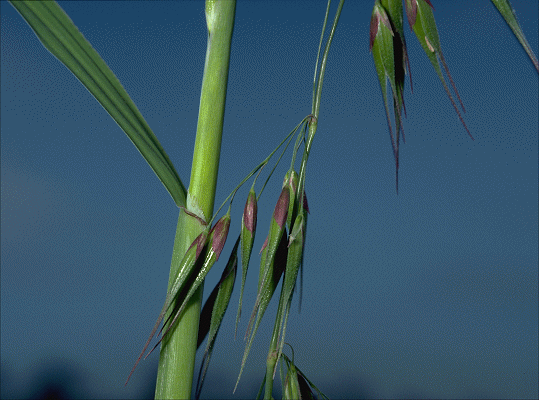Ehrharta longiflora* Sm. Pl.Icon.
Tab. 32 (1789).
Classification. (GPWG 2001) : Subfamily
Ehrhartoideae. Tribe Ehrharteae.
Type of Basionym or
Protologue Information: Ad Prom. Bonae Spei, Masson (HT: BM [hb.
Banks]).
Key references
(books and floras): [1878] G.Bentham, Flora Australiensis 7 (551),
[1952] C.A.Gardner, Flora of Western Australia 1 Gramineae (18),
[2002] D.Sharp & B.K.Simon, AusGrass, Grasses of Australia, [2002]
J.Wheeler, N.Marchant & M.Lewington, Flora of the South West (414), [2006]
J.Jessop, G.R.M.Dashorst, F.M.James, Grasses of South Australia (56),
[2008] S.W.L.Jacobs, R.D.B.Walley & D.J.B.Wheeler, Grasses of New South
Wales (234), [2009] A.Wilson (ed.). Flora of Australia, Vol 44A. Poaceae
2 (374).
Illustrations:
[1952] C.A.Gardner, Flora of Western Australia 1 Gramineae (20,
Pl. 3), [2006] J.Jessop, G.R.M.Dashorst, F.M.James, Grasses of South
Australia (57, Fig. 21), [2008]
S.W.L.Jacobs, R.D.B.Whalley & D.J.B.Wheeler, Grasses of New South Wales,
4th edn (234), [2009]. A.Wilson (ed.), Flora of Australia 44A: Poaceae
2 (372, Fig. 50).
Habit. Annual.
Culms erect or geniculately ascending or decumbent, 30–120 cm tall. Mid-culm
internodes glabrous. Leaf-sheath auricles present. Ligule a fringed membrane, a
ciliolate membrane, 1.5–3 mm long, membranous. Leaf-blades flat, 7–20 cm long,
5–15 mm wide. Leaf-blade surface glabrous.
Inflorescence.
Inflorescence compound, a panicle. Panicle lanceolate, loose, 10(–40) cm long.
Spikelets.
Spikelets pedicelled. Fertile spikelets 1 or more flowered, with 1 fertile
floret, comprising 2 basal sterile florets, comprising 1 fertile floret(s),
without rachilla extension, oblong, laterally compressed, 10–25 mm long.
Glumes. Glumes
similar, thinner than fertile lemma. Lower glume ovate, membranous, keeled,
1-keeled, 5 -nerved. Upper glume ovate, 3.5–6 mm long, membranous, keeled,
1-keeled, 7–9 -nerved. Florets. Basal sterile florets 2 or more, barren,
without significant palea. Lemma of lower sterile floret 100 % of length of
spikelet, coriaceous, 1-keeled, mucronate or awned. Lemma of upper sterile
floret 9–12 mm long, mucronate or awned.
Fertile
lemma 8–10 mm long, keeled, 7 -nerved. Lemma surface glabrous. Palea 1–2
-nerved. Lodicules present. Anthers 4–6.
Continental
Distribution: Africa and Australasia.
Australian
Distribution: Western Australia, South Australia, Queensland, New South
Wales, Victoria, Tasmania.
Western Australia:
Irwin, Drummond, Warren, Eyre, Avon. South Australia: Nullabor, Flinders
Ranges, Eyre Peninsula, Northern Lofty, Murray, Yorke Peninsula, Southern
Lofty, Kangaroo Island, South-eastern. Queensland: Darling Downs. New
South Wales: North Coast, Central Coast, South Coast, Central-Western
Slopes, South-Western Slopes, North-Western Plains, South-Western Plains. Victoria:
East Gippsland, Gippsland Plain, Grampians, Lowan Mallee, Midlands, Murray
Mallee, Otway Plain, Otway Range, Wilsons Promontory, Riverina, Volcanic Plain,
Wannon, Wimmera. Tasmania: Furneaux Group, North West, North East,
Midlands, East Coast.
Notes.
An unimportant weed of orchards and nurseries.
Introduced.
All states but N.T. In seasonally wet places and at edges of watercourses,
often in disturbed places where water is available. Flowers July-Oct.




